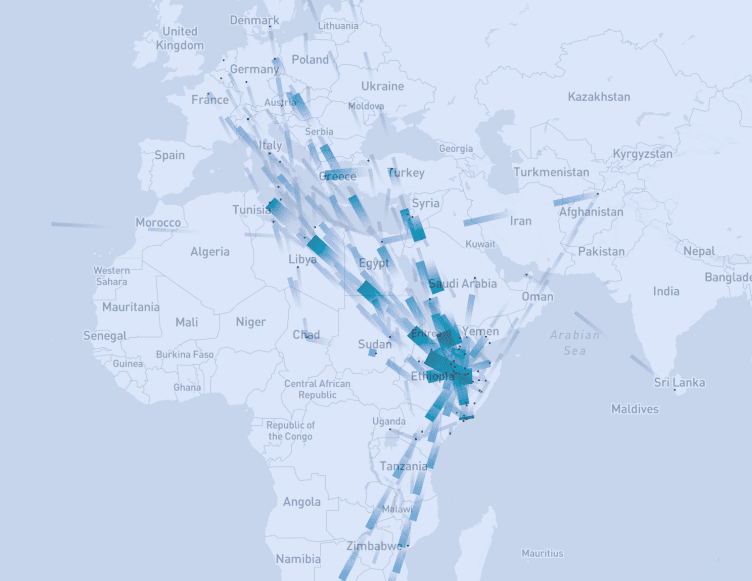
Human Trafficking and Risky Migration Routes: DATA insights from SOMALI Civil Society Organisations
Human trafficking and smuggling are extremely frequent in East Africa, with the majority of migrants being introduced into smuggling routes within the larger context of international migration. The main routes lead respectively towards South Africa, Yemen and Saudi Arabia, and the Mediterranean (Malta and Italy, or Greece and Turkey), where women, men and children are trafficked for a range of purposes, including forced and exploitative labour in factories, farms and private households, sexual exploitation, and forced marriage.
To support the fight against human trafficking, we the Somali Civil Society Organisations (CSO) Coalition which is an informally organised group of anti- trafficking CSOs working in South-Central Somalia, Somaliland, Puntland and Jubaland, conducted a mapping of human trafficking routes. This mapping exercise will provide us with crucial information in the fight against human trafficking, such as trafficking hotspots, routes, modes of transport and types of exploitation. This will empower us to better target our interventions to prevent human trafficking the areas where we work.
Through this report, we aim to support civil society, law enforcement, the private sector, and government by increasing their access to evidence-based data on human trafficking that can support strategic decision making. The joint data collection exercise brought together information and relevant data about locations, routes and context information to analyse the dynamics of human trafficking and exploitation and the experiences of Somali migrants abroad.
In this document, the Somali National CSO Coalition seeks to extend the availability of relevant data on human trafficking and unsafe migration routes for civil society and other Somali stakeholders. It is our hope that this document will serve as a reminder of the added value that civil society brings into our joint efforts to combat human trafficking.
The Somali CSO Coalition would like to give a very special thanks to Freedom Collaborative for their invaluable support in conducting the data analysis and designing and developing the report itself. The content of the report, to the greatest extent possible, reflects the findings elicited through the data collection exercise conducted by the participating CSOs.
We would like to thank the following CSOs for their invaluable time and energy towards the data collection process: Candle of Hope Foundation (CoHF), IIDA Women’s Development Organisation (IIDA), Tadamun Social Society (TASS), Voices of Somaliland Minority Women Organisation (VOSOMWO) and Women’s Action for Advocacy and Progress Organisation (WAAPO). Unquestionably, this document would not have been possible without their contributions.
Last, but not least, we extend our gratitude to the Better Migration Management II Programme (GIZ) for facilitating the process, providing logistical support, translation and the roll-out of the final report. The BMM Programme (GIZ) continue to provide their relentless support and never-ending efforts to the CSOs in the Somali CSO Coalition working on anti- trafficking and the protection of vulnerable migrants in East Africa.
SUMMARY OF FINDINGS
- In total, this report brings together data from 206 route submissions by the participating organisations. The submitted routes refer to a total of 28 countries as origin, transit and destination locations. Eight countries have been mentioned as countries of origin. As destinations, 25 countries have been identified, and five countries – Afghanistan, Chad, Egypt, Malta and the United Arab Emirates – have been mentioned as transit locations.
- The most reported origin and destination combinations include: (1) Ethiopia to Yemen, with Somalia as transit location, (2) Somalia to Italy, (3) Somalia to South Africa, (4) Somalia to Germany, (5) Ethiopia to Saudi Arabia, with Somalia as transit location, and (6) Somalia to Saudi Arabia.In the majority of cases, the migrants received help from at least one other person when planning or making their journey, with the most commonly identified facilitators being recruitment agencies. Other types of facilitators included labour brokers/agents, smugglers, friends, family members and the employer themselves.
- Analysis of the collected data shows a significant variation in the length of the migration journeys and their cost – this variation was not just attributable to different destinations but also to the individual experiences of migrants travelling to the same destinations. When looking at the correlation between length of the journey and cost, a relationship between the two could not be identified.
- Within the data set, a wide range of industries of exploitation have been mentioned. The most referenced industry is domestic work, followed by agriculture, construction, commercial sex and begging. Forced labour is the most commonly cited type of abuse or exploitation in the submissions, followed by physical violence and sexual violence.
- This is the first time that the participating organisations have contributed to a structured data collection exercise concerning human trafficking and risky migration routes that relate to South-Central Somalia, Somaliland, Jubaland and Puntland. The collected data contributes to addressing the lack of consolidated credible data and information on current trends and risks for human trafficking and other forms of exploitation across the region. We applaud the organisations for participating in this data collection that highlights how much knowledge is available when information is brought together and shared.
Read full report here.
Learn more about Freedom Collaborative here.
